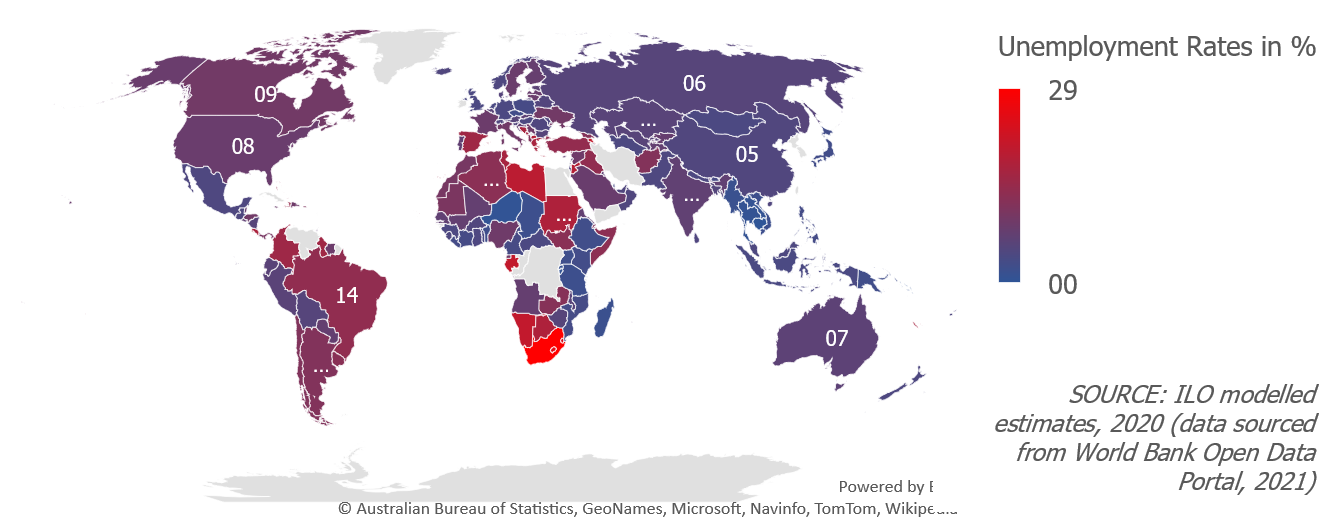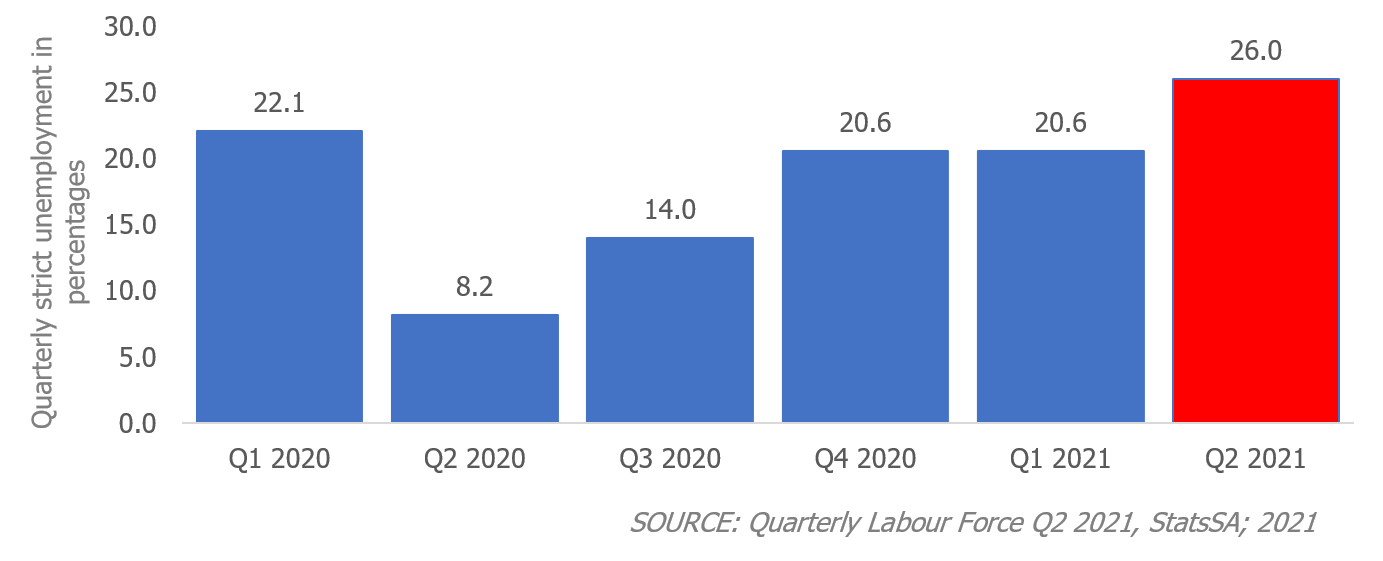
UNEMPLOYMENT AT ITS HIGHEST IN HISTORY
At a strict rate of 34,4%; South Africa’s unemployment rate is the highest in the world. This is according to the World Bank, which in response to StatsSA’s Quarterly Labour Survey reports that the country’s unemployment is at its highest in 13 years. This datastory addresses this performance at the City level, as well as possible reasons for it.

SOUTH AFRICA UNEMPLOYMENT
South Africa’s Q2 2021 unemployment rate figures were released by StatsSA in August 2021, placing performance of the labour market at its worst in years. Strict unemployment nationally, increased by 2% to 34,4%; adding 584 000 more unemployed people to the country. However, this measure only takes into account people actively looking for work; where in reality (i.e. expanded unemployment rate) 44,4% of South Africans eligible and willing to work, cannot find employment. 54 000 South Africans lost their jobs between April and June 2021(compared to 28 000 the previous quarter) and 447 000 people entered the labour force by becoming eligible and willing to work. The map below highlights this issue by contextualising this performance globally. According to the International Labour Organisation, in 2016 South Africa overtook Bosnia and Herzegovina as well as North Macedonia as having the highest unemployment rate globally. While it is important to note that not all countries are fully transparent with their data reporting (while many do not have national data standards as robust as South Africa’s) it is still a cause for concern and should be investigated at the City level.
DURBAN UNEMPLOYMENT
Figure 2- Durban’s Quarterly Unemployment

Durban’s unemployment rate increased to 26% between April and June 2021; its highest rate in 26 quarters, or in the history of the survey in South Africa’s metros. When considering those people who have given up hope of finding work, this increases to 36,9% of the labour force being unemployed (an increase of 2% from the previous quarter). Although South Africa has the world’s highest (reported) unemployment rate; Durban appeared to perform worse, quarter on quarter than both the country and its major metro counterparts for most indicators. This is, when considering the following;
• Unemployment increased by 0,5% on average across all other major cities, while it increased by 6% in Durban. Despite increasing unemployment levels, Gauteng cities added 109 000 jobs to the country's economy. During this period however Durban (and Cape Town, both significant beach tourism destinations) shed jobs. Durban in particular shed 51 000.
• At an additional 2 000 discouraged work seekers in Durban compared to a decline of 500 in other major cities, Durban appears to have borne the brunt of unemployed people who have lost hope of finding work.
• Finally, while the chances of finding a job increased on average across other major cities, they declined by 5% quarter on quarter in Durban.
Nonetheless, Durban’s strict unemployment rate is still the lowest of all major cities – albeit due to a higher proportion of discouraged work seekers. Perhaps what arose as one positive aspect of the labour market’s recently released performance is that the proportion of discouraged work seekers have decreased across most cities; indicating more work seekers have higher hopes of finding jobs. This may be in response to the increase in positive economic activity across the country; with Durban reporting the most optimism amongst work seekers; or the highest proportional drop in discouraged work seekers of all metros(and even when compared to the country).
FACTORS DRIVING UNEMPLOYMENT
Nationally, those industries which shed jobs are also three of Durban’s top employers; Finance, followed by Community and Social Services, as well as Manufacturing. Various factors appeared to have contributed to this poor performance. This included the increased spate of load shedding in April, as well as the national surge ofCovid19 cases nationally and subsequent movement to Lockdown Level 4 restrictions. While this was only in June, the Gauteng travel ban during a peak tourism season was significant for Durban’s economy. This decline appears to have thwarted the positive trend of labour recovery from the initial April 2020 hard lockdown and will take concerted effort to rectify following the July 2021 unrest.
CONCLUSION AND RESPONSES TO UNEMPLOYMENT
It is undeniable that the problem of unemployment is chronic and structural. A such, it is important that various approaches become engrained in all sectors of society; including leaders and role players in the public, private, and civil sectors. This includes re-industrialisation of the City’s economy, including localisation as well as support for local producers, renewed investment and investment facilitation in targeted industries; innovation in investment facilitation through a government that is capable, customer-centric, enabling, efficient and integrated, and finally; ensuring that our engagements, transactions and strategies in addressing the economy are inclusive and shared as far as possible. This directly addresses three of the five strategic focus areas of the Sakha iTheku Shape Durban Strategy. The strategy, which is currently being updated; was developed as a widely consulted social pact between stakeholders from all spheres of society in order to achieve inclusive growth and sustainable job creation in Durban. In so far as it is caused by City level factors; a return to core values jointly developed in the strategy is critical in addressing the recurring problem of unemployment.